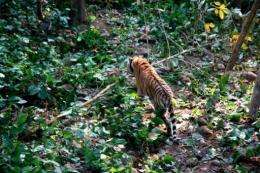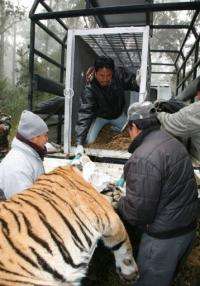Nepal uses satellites to track rare tiger

An injured wild tiger that strayed into a tourist resort in Nepal has been moved to a new home in the jungle and fitted with a satellite collar so its progress can be tracked, the government said.
The tiger, an adult male, was captured after it wandered into the resort on the outskirts of the Chitwan national park in southern Nepal, a major tourist attraction, and nursed back to health by park authorities.
It was then driven about 600 kilometres (400 miles) with a team of vets and conservationists in a specially constructed trailer to the remote jungles of Bardia in western Nepal, where it was released on Saturday.
The tiger, named Namobuddha by park authorities, has been fitted with a special collar carrying a GPS tracking system that will allow scientists to monitor how well it adapts to its new home.
The government said the initiative, carried out with the help of experts from WWF, would also help to improve understanding of how the endangered animals behave in the wild.
"This translocation -- the first of its kind in Nepal -- is a concrete example of our commitment to saving wild tigers using the best science available," said Deepak Bohara, minister of forest and soil conservation.
The project is part of Nepal's efforts to double its population of Royal Bengal tigers, which once roamed the country's southern plains in large numbers but have been depleted by poaching and the destruction of their habitat.
A WWF survey carried out in 2008 found just 121 adult tigers of breeding age in the country.

Krishna Acharya, Nepal's head of national parks and wildlife conservation, said Bardia was an ideal home for the animal because it of its vast size, available prey and relatively low levels of poaching.
"Nepal is one of the countries in the world where the prospect of doubling the tiger population is quite good, if tigers are given enough space, prey and proper protection," he added.
Experts say poverty and political instability in Nepal have created ideal conditions for poachers who kill the animals for their skin, meat and bones, which are highly valued in Chinese traditional medicine.
The WWF says tigers are in serious danger of becoming extinct in the wild. During the last 100 years their numbers have collapsed by 95 percent, from 100,000 in 1900 to only around 3,200 tigers, its says.
(c) 2011 AFP



















